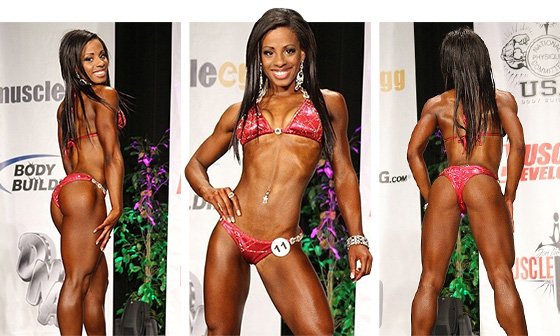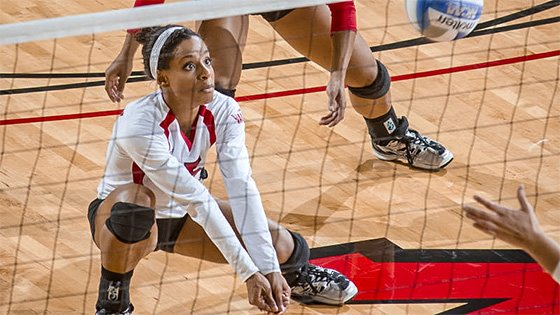Picture this: You've busted your butt in the gym day-in and day-out to reach your fitness goals and achieve the body you want. You've built your shoulders, toned your arms, and carved a rock-hard core. You've trained your upper body to perfection, but your lower-body is lagging. It's time to get off the machines and hit your lower body hard!
When it comes to a great physique, symmetry is key, and your legs and glutes are your foundation. Train them hard, and you'll get the results you want!
Some people are recognized as "fit" gym-goers by their arms, shoulders, or abs, but even at 13 percent body fat, my legs were the first body part people would notice when I was an NCAA Division-I athlete. My legs would spur questions like "Do you run track?" or "Are you a gymnast?"
While I'd dabbled in both when I was very young, I actually have defensive volleyball skills to thank for helping me build powerful, toned legs.
Volleyball Base, Bikini Beauty
I still remember waking up on brisk fall mornings, eating a quick breakfast, and walking into the locker room groggy-eyed and half asleep. Even so, once the kneepads and spandex were on, I was ready for business. I may have been tired from studying or sore from lifting, but I was always determined to angle my passing platform just right.
My legs were the foundation to receive any 40 mph serve coming at me. Since I graduated in May 2012, I've traded in my pads and spandex for the bikini and clear heels that come with being an IFBB Bikini Pro. That doesn't mean I don't still train like an athlete.

People often think that bikini athletes don't have to lift heavy or hard. For me, that's not true. I spent 10 years of my life as a volleyball defensive specialist, or "libero." During that time, I lifted primarily for strength. I wasn't lifting for a beautiful, balanced physique in those days, but the time I spent maxing out on squats, front squats, sprints, and prowler pushes have helped me transition into success in bikini.
Though I'm no longer on the court, I still integrate the moves I learned during tough volleyball practices to intensify my workouts. As an athlete, my focus has been conditioning, endurance, and strength, which each of the following volleyball moves targets.
These moves will also help you build a killer bikini bottom. I incorporate them into my workouts for additional conditioning between working sets of my lower-body workouts. I don't use them as a stand-alone leg workout.
1
Squat Hold

Squat as if you're sitting back in a chair. Keep your feet shoulder-width apart and your knees behind your toes. All your weight should be on your heels. I like to go low enough for my hands to touch the ground.
This is a common stance during a volleyball match when you're defending a play. This move targets your thighs, hips, glutes, and quads—just don't make the rookie mistake of bending with your back.
Aim to hold this for 30 seconds, and increase your time progressively. Not only will move this help build leg strength, steadily increasing the duration of the hold will build endurance!
For a beginner I recommend 3 sets of 30 seconds. More advanced trainees should try 3 sets of 1 minute. This is a great move to use on your current leg training day.
2
Towel Pushes
Let me tell you, cleaning is hard work! Before every practice, my team and I would perform towel pushes—basically polishing every inch of what felt like an endlessly long court.
It turns out buffing floors makes for a buff body. This exercise engages your lower body, builds speed, and utilizes your core. The form is similar to a sprint start, where you are bent over and hinged at the waist, except your palms will be flat on a towel on the ground.
When cleaning the courts, we would go slow and steady for a great warm-up. For a heart-pounding workout, pick up the pace and make it a suicide drill. Use a basketball court or your gym's studio to do suicide sprints. You can also try a series of studio-length sprints at your gym, rest for 20 seconds, and then repeat.
Tips
- Sit back into your stance and take longer strides to focus on your hamstrings as you plow through this exercise.
- Push through the balls of your feet and lean forward to target your quads.
3
Stair Climbing
Sometimes I'll take my cardio off the machines and run stairs. You can do these at home, at the gym, or at a nearby stadium. They're more dynamic than the StairMaster because you don't have rails to rely on for support and your body is in charge of creating all the momentum.

The key is to increase your heart rate by running both up and down the stairs, so be sure not to cheat yourself. I shoot for 20 "reps" per session—up and down counts as 1 rep—or I like to break my workout into sets of 5 with plyometrics between each run.
I like to hit 15 jump squats or pop squats before I go back up for my next set of stairs. Start at your own pace; build up your total volume as you train.
Tip
When using stairs or bleachers, I focus on stepping with my whole foot, not just my forefoot. This allows me to use the power of my whole leg, not just my quads.
4
Lateral Shuffles
Pick two points on a basketball court, such as either end of the free throw line. Focus on good form—avoid feet crossovers—and stay low to the ground. While squatting deep with your weight in your heels, shuffle for time or reps, bending sideways to touch the line each time.
If you don't have access to a basketball court, use two cones to mark your sidelines or go simple with a water bottle and a towel. The key is to get from point A to B quickly and efficiently. Sit with your chest lifted high, and move wide to cover as much space as possible in one stride.

Focus on using your legs to power your movements. When you're tired, you may find yourself bending with your back instead of at the waist. Don't cheat yourself; put those legs to work! You can even switch it up with diagonal patterns.
5
Wide Monster Lunge
At any moment during a volleyball match, you may have to dive to the floor to save a ball or dig a hit. In a long rally, you may be shuffling and running around for minutes at a time. The ball can get shot to the floor in an instant, but the play will start right back up again. Take a cue from this when it comes to lunges: Go hard and strong with little rest.
Recreate volleyball recovery moves, minus the volleyball, by lunging forward on a 45-degree diagonal to either side of your body. Use momentum from your legs, extend the arm of the same leg you stepped out with, then bring that arm to the floor like you're going to save a low ball. You will feel a stretch deep in your hamstrings when you bring your forearm to the floor.

